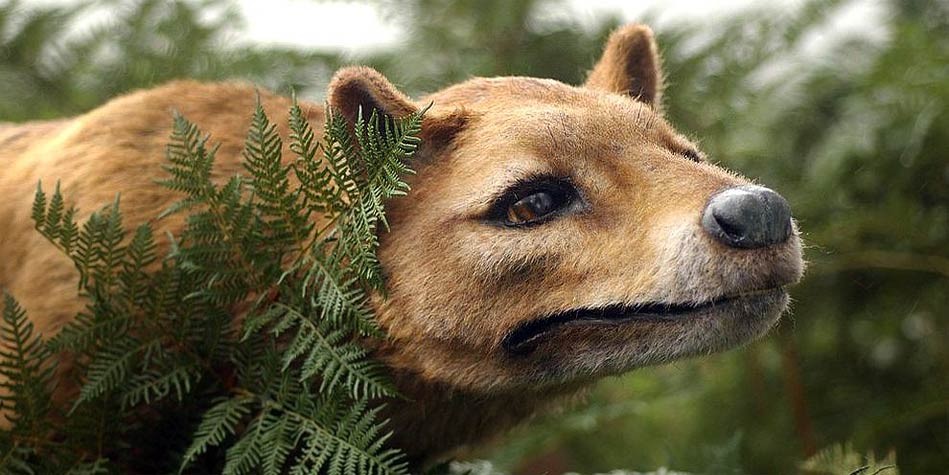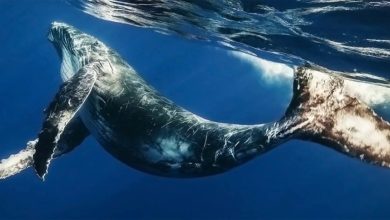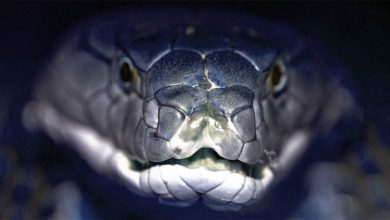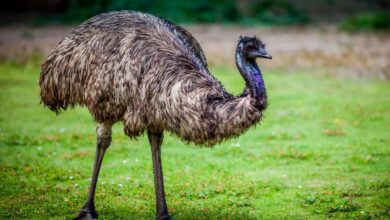Tasmanian tiger, Tasmanian wolf (Thylacine)
Thylacine, Tasmanian tiger, Tasmanian wolf (Thylacinus cynocephalus)
A marsupial that was most similar to a wolf. Today, no one can see it alive, yet several videos showing the behavior of this unusual creature creature, as well as many written descriptions of its habits have remained. The spirit of Tasmanian tiger is still alive. It is a pity that only its spirit survived…
Today we set for the relatively recent past, to the other hemisphere. We will reach Australia and Tasmania as the first settlers. We will see many nostalgic black and white photographs and get to know the animal that still lived when our grandparents were still little children.
Classification:
- Kingdom: Animalia
- Phylum: Chordata
- Class: Mammalia
- Infraclass: Marsupialia
- Order: Dasyuromorphia
- Family: †Thylacinidae
- Genus: †Thylacinus
- Species: †Thylacinus cynocephalus

Areas of occurrence
Australia, Tasmania and New Guinea were its natural habitats, after the expansion of European settlers and spread of the dingo species (Canis lupus dingo) thylacines survived only on the Tasmanian islands, which finally could not grant their survival as well.
Not much is known about its life and habitats in the wild. Some conclusions were made based on observation of the wolves held in captivity. They were mostly observed during the day, yet it was not their nature as these predatory marsupials did not become active until nightfall.
Some of its presumed habits were rather inherited from its closest relative – the Tasmanian devil (Sarcophilus harrisii).
It probably lived in the eucalyptus forests, swamps and meadows in the whole Australia. In Tasmania it preferred the coastal heaths, which became the main target for British settlers seeking pastures for their livestock.

Characteristics
It closely resembled a large dog with short pelage and a long, stiff tail, which could be an extension of the spine, as kangaroos’ tails. Many settlers compared it to a hyena due to a similar way of moving and a general silhouette line.
Pelage
Its hair was yellow-brown, decorated with from 13 to 21 distinctive dark, transversal stripes stemming in the middle of its back, ending in the rump and base of its tail. The visible stripes are the reason this animal is sometimes called a tiger. They were most apparent on young wolves, disappearing with age. One of the stripes reached the outer thigh.
Its fur was thick and soft, ears jutting, round in shape, reaching 8 cm of length, covered with short hair. The coloration was rather varied: from light to dark brown, with a cream-colored abdomen.
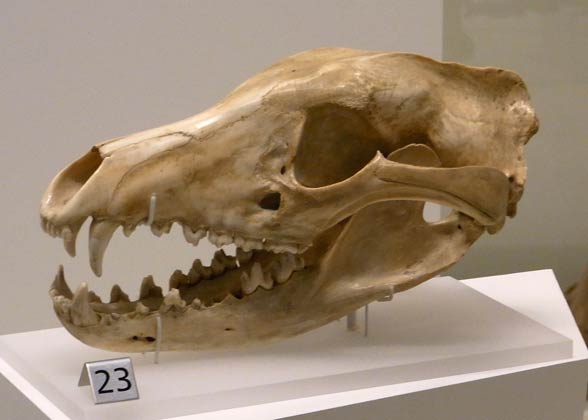
Pouch
Females had pouches (skin folds covering the nipples) with 4 nipples, but – unlike many other marsupials – the pouch opened to the rear, not to front.
Males Tasmanian tigers had scrotums which was extraordinary for Australian marsupials.
Jaws
The jaw was equipped with 46 teeth and amply muscled, yet not very strong. The thylacine’s mouth opening could reach 120o. It is the widest any mammal could ever open its mouth. Any animal capable of a wider opening is the saber-toothed tiger (smilodon).
Paws
Thylacine’s paw print could be easily distinguished from other animals’ traces, as its rear feet were considerably large. Rear and front paws were similar, yet the rear limbs had 4 toes, while the front had 5, the claws could not be covered.
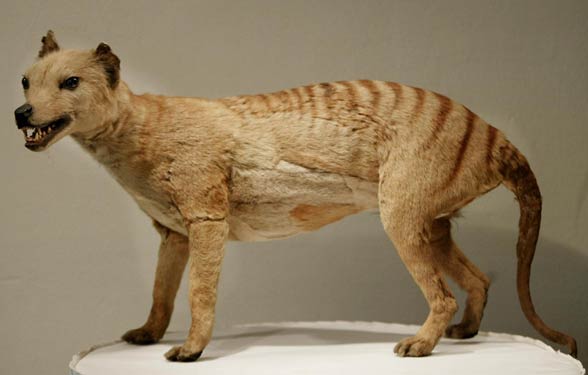
Senses
Research suggests that the Tasmanian tiger had a very responsive sense of smell allowing it to follow its prey, although the brain analysis indicates that the olfactory bulbs were very poorly developed. It is possible that it based on its vision and hearing during hunts.
Smell
There are records of the strong odor it had, other witnesses state that it had a gentle ‘crystal’ animal smell, although there is a group of people claiming that it had no scent at all.
As a result it has been established that – like the Tasmanian devil – it released a strong odor when in danger.
Jumps
It could also perform two-legged leaps similarly to kangaroos’ jumps. Conceivably it allowed it to move faster when in danger, as its ordinary walk was rather slow and clumsy.

Vocalizations (sounds)
People observing those animals in the wild noticed that they emit several kinds of vocalizations: they growled, hissed and opened their mouth wide, when they felt discontent or angry. During hunts they emitted guttural sounds that sounded like coughing, most likely a mean of communication between members of a given family. They could also cry shrilly to identify themselves from a large distance. They also emitted low, nasal sounds used to communicate with other wolves in the pack.
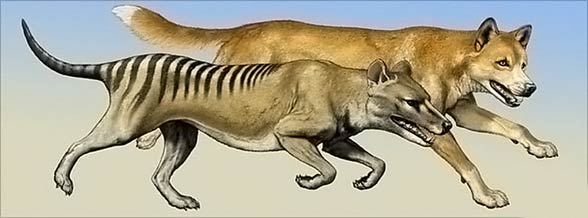
Diet
It was a carnivorous species. The stomach was adapted to acquiring large portions of food at once- it could stretch substantially. Such adaptive skills can be related to long periods of unsuccessful hunts and rare eating opportunities. Supposedly it hunted in small family groups, hiding and awaiting prey, striking with the element of surprise.
Not much is known about the thylacine’s dietary habits and its manner of eating. Experts claim that it ate kangaroos, red-necked wallabies, wombats, birds and small mammals.
In captivity it was fed with dead rabbits, wallabies, beef, mutton, horseflesh, sometimes poultry.
A biologist – Michael Sharland – published an article in 1957, which stated that thylacines did not want to eat dead wallabies, but they finally got convinced by the smell of the blood in the fresh meat. Tasmanian tigers themselves became prey to dingoes and foxes brought to their habitat by European settlers.
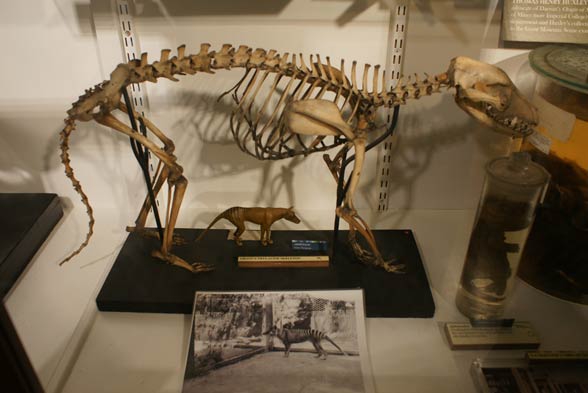
Behavior
It led a dusk-nighttime life style, spending the days in small caves or hollow tree trunks, which it made lairs in. During the day it lived in the forests and in hilly areas, whereas it hunted in the open heaths at night. Early observations indicated that these animals were rather shy and timid, as they were well aware of human presence and avoided confrontation at all cost, yet sometimes, out of curiosity, they approached human settlements. However in that period they had a bad reputation of vicious cattle killers.
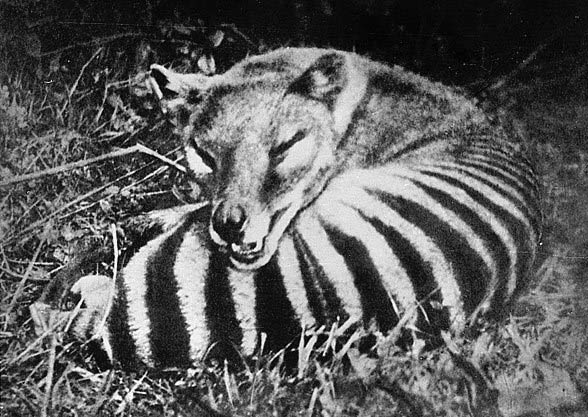
Breeding
It has been proven that the thylacine was capable of breeding all year long. Female hunting victims carrying offspring in their pouches are the evidence for such a state of matters. The peak season of breeding was in winter and spring months. One litter consisted of up to 4 joeys (2, 3 on average).
The mother carried them in the pouch for about 3 months, taking care of them at least to the point of them reaching the half of their mature size. Newborn thylacines were blind and bald, but their eyes were open. When leaving the maternal pouch, they were already covered with thick fur.
When did the Tasmanian tiger become extinct?
The thylacine survived in Tasmania until 1930, however it was blamed of killing sheep and hunted for, which led to a total extinction of the species. Other contributing factors in other habitats may have been the invasive dingo dominance, diseases and loss of habitats triggered by a growing number of cattle, which was pastured in the Tasmanian wolf’s natural living and hunting areas.
Last wild thylacines were seen in 1932. The last Tasmanian wolf died in captivity in 1936 in the Hobart Zoo (capital of Tasmania).
Supposedly a small population survived in the wild until the 1960. but there is no hard evidence for such a phenomenon. The species is officially considered extinct since 1986.

Detailed characteristic/size
Thylacine / Tasmanian tiger / Tasmanian wolf (Thylacinus cynocephalus)
- Length: 100 – 130 cm (3ft 3in – 4ft 3 in)
- Tail length: 50-65 cm (1 ft 7.7 in – 2 ft 1.6 in)
- Height at shoulders: about 60 cm (1 ft 12 in)
- Weight: 20-30 kg (44 lb – 66 lb)
- Ears: 8 cm (3.1 in)
- Lifespan: 5-7 years in the wild, up to 9 years in captivity
The Tasmanian wolf showed a moderate sexual dimorphism – males were slightly larger than females.
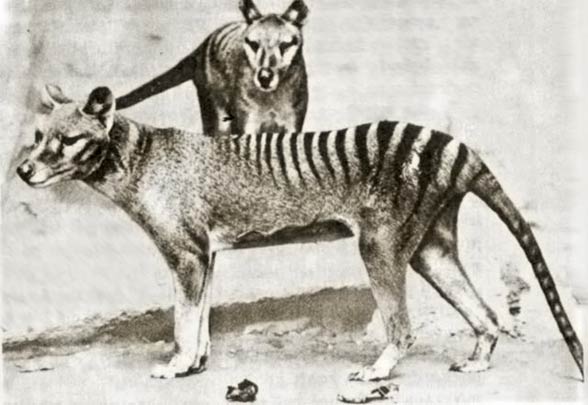
Thylacine – interesting facts
- A first detailed scientific description of the Tasmanian tiger was created by George Harris in 1808, 5 years after the first settlers’ arrival.
- Cave paintings in the Kakadu National Park clearly show that the Tasmanian wolf was a hunting target for the primitive people.
- Thanks to aboriginal Australians’ cave paintings discovered in 1990 in the Nullarbor Plain cave it has been established that thylacine inhabited the whole Australian continent, as well as New Guinea. Radiocarbon dating has shown that the paintings are 3300 years old.
- European settlers believed that thylacine hunted for sheep and fowl. Throughout almost entire XX century it was said to drink its victims’ blood.
- Conceivably the stripes on the rear parts of its body were a form of camouflage in the thick forests, yet it could also serve as a mean of intra-species identification.
- Thylacine could stand upright on its rear paws.
- The skeleton and observations of specimens held captive lead to a conclusion that thylacine waited for and hunted for certain animal species, seeking them until their population was depleted.
- One of thylacine’s victims was the Tasmanian emu, a large bird which has become extinct around 1850.
- Thylacine had extraordinarily weak jaws. It had a theoretical potential for hunting for animals about its own size, but a 30 kg (66.13 lb) wolf would prove unable to acquire prey exceeding 5 kg (11.02 lb)of weight.
- In 2011 experts has established that thylacine ate only small animals, which would prove its competition with the Tasmanian devil and tiger quoll (Dasyurus maculatus), which leads to a conclusion that the Tasmanian wolf was prone to extinction due to a natural imbalance in the ecosystem.
- Thorough research has shown that numbat (Myrmecobius fasciatus) could be a closer relative for the thylacine than Tasmanian devil.
- Thylacine is often featured in Tasmanian symbols – e.g. it is pictured in the coat of arms of Tasmania.
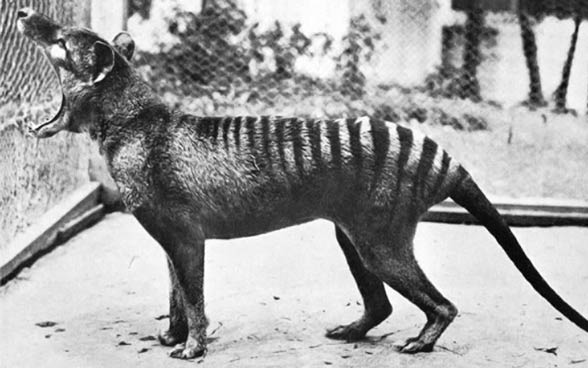
Recommended
- Extinct animals
- Elasmotherium
- Archaeopteryx
- Sarcosuchus
- Deinosuschus
- Animals & dinosaurs records
- The fastest animals – Top 100
- The fastest birds – Top 10
- The heaviest dinosaurs – Top 10
- The longest dinosaurs. Sauropods Top 10
- The longest predatory dinosaurs. Theropods Top 10
- The heavies predatory dinosaurs Top 10
- The longest and largest ornithopods
- The longest and largest ceratopsians
- The shortest sauropods
- The smallest dinosaurs – Top 10

